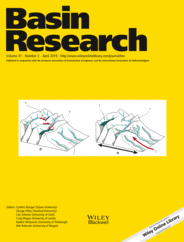
Full text loading...
 , Julien Babault2, Stéphane Dominguez3, Jean Van Den Driessche4, Xavier Legrand5
, Julien Babault2, Stéphane Dominguez3, Jean Van Den Driessche4, Xavier Legrand5
Drainage networks link erosional landscapes and sedimentary basins in a source‐to‐sink system, controlling the spatial and temporal distribution of sediment flux at the outlets. Variations of accumulation rates in a sedimentary basin have been classically interpreted as changes in erosion rates driven by tectonics and/or climate. We studied the interactions between deformation, rainfall rate and the intrinsic dynamics of drainage basins in an experimental fold‐and‐thrust belt subjected to erosion and sedimentation under constant rainfall and shortening rates. The emergence of thrust sheets at the front of a prism may divert antecedent transverse channels (perpendicular to the structural grain) leading to the formation of longitudinal reaches, later uplifted and incorporated in the prism by the ongoing deformation. In the experiments, transverse incisions appear in the external slopes of the emerging thrust sheets. Headward erosion in these transverse channels results in divide migration and capture of the uplifted longitudinal channels located in the inner parts of the prism, leading to drainage network reorganization and modification of the sediment routing system. We show that the rate of drainage reorganization increases with the rainfall rate. It also increases in a nonlinear way with the rate of uplift. We explain this behaviour by an exponent > 1 on the slope variable in the framework of the stream power erosion model. Our results confirm the view that early longitudinal‐dominated networks are progressively replaced by transverse‐dominated rivers during mountain building. We show that drainage network dynamics modulate the distribution of sedimentary fluxes at the outlets of experimental wedges. We propose that under constant shortening and rainfall rates the drainage network reorganization can also modulate the composition and the spatial distribution of clastic fluxes in foreland basins.

Article metrics loading...

Full text loading...
References


Data & Media loading...
Supplements

